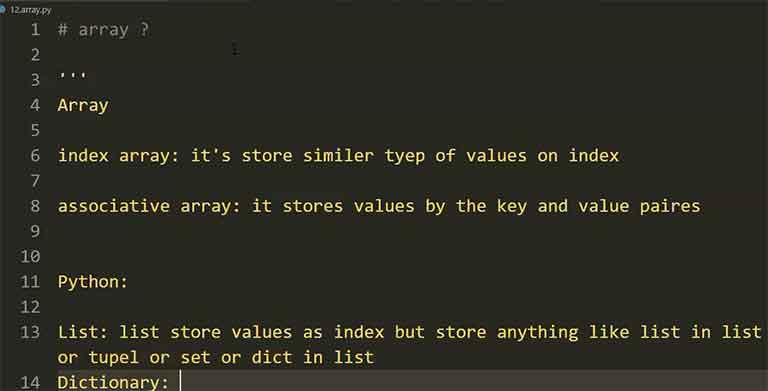Post Contents
Arrays in Python programming language are Data Structures that can hold multiple values of a similar sort. Frequently, they are misinterpreted as lists or Python Numpy Arrays. In fact, Arrays in Python are unmistakable from both these. So we should feel free to see what Arrays are in Python and how to create an array in python.
Here’s in the Python Course in Laxmi Nagar an outline of the topics which clarifies all the aspects of managing arrays:
you may experience the webinar recording of Python Arrays where our python training in Delhi master has clarified the topics in a nitty-gritty way with models that will assist you with seeing all ideas identified with Python Arrays.
Why use Arrays in Python?
A mix of Arrays, along with Python could spare you a ton of time. As referenced before, arrays assist you with lessening the overall size of your code, while Python causes you to dispose of problematic syntax, in contrast to different dialects.
For example: If you needed to store integers from 1-100, you won’t have the option to recollect 100 variable names explicitly, in this manner, you can spare them easily utilizing an array.
What is an Array in Python?

An array is fundamentally a data structure which can hold more than each incentive in turn. It is an assortment or requested arrangement of elements of a similar sort.
It will be good if you learn Data Science course in delhi yourself by joining the Django training in delhi
Model:
1
a=arr.array(‘d’,[1.2,1.3,2.3])
We can circle through the array items easily and get the necessary values by simply indicating the list number. Arrays are mutable(changeable) also, along these lines, you can perform different manipulations as required.
Presently, there is consistently an inquiry that surfaces to our brain –
Is Python list the same as an Array?
Python Arrays and lists are store values likewise. However, there is a key contrast between the two i.e the values that they store. A rundown can store any kind of values, for example, integers, strings, and so forth. An array, then again, stores single data type values. In this manner, you can have an array of integers, python array of strings, and so on.
Python additionally gives Python Numpy Arrays which are a framework of values utilized in Data Science. You can investigate Python Numpy Arrays and Python array vs list to know more.
You can join our python course in Delhi to become an expert as a python developer.
How to create array in python:
Arrays in Python can be made in the wake of bringing in the array module as follows –
→ import array as arr
The array(data type, esteem list) work takes two parameters, the first being the data sort of the incentive to be put away and the second is the worth rundown. The data type can be anything, for example, int, float, double, and so forth. Kindly make a note that arr is the moniker name and is for usability. You can import without a false name too. There is another approach to import the array module which is –
→ from array import *
This implies you need to import all capacities from the array module.
The accompanying syntax is utilized to make an array.
Syntax:
1
a=arr.array(data type,value list) #when you import utilizing arr false name
Or on the other hand
1
a=array(data type,value list) #when you import utilizing *
Model: a=arr.array( ‘d’ , [1.1 , 2.1 ,3.1] )
Here, the first boundary is’ which is a data type for example float and the values are determined as the following boundary.
Finding the Length of an Array
Length of an array is the number of elements that are really present in an array. You can utilize len() capacity to input array in python. The len() work restores integer esteem that is equal to the number of elements present in that array.
Syntax:
→ len(array_name)
Model:
1
2
a=arr.array(‘d’, [1.1 , 2.1 ,3.1] )
len(a)
Yield – 3
This profits an estimation of 3 which is equal to the number of array elements.
Including/Changing elements of an Array:
We can increase the value of an array by utilizing the add(), extend() and the insert (i,x) capacities.
The annexe () work is utilized when we have to include a solitary component toward the finish of the array.
Model:
1
2
3
a=arr.array(‘d’, [1.1 , 2.1 ,3.1] )
a.append(3.4)
print(a)
Yield –
array(‘d’, [1.1, 2.1, 3.1, 3.4]) To get top to bottom information on Python alongside its different applications, you can select for a python course in Delhi with the industry’s best modules.
Recommended Blog:

- Python Sets And Dictionaries Python Lists, Python Sets & Dictionary
- Difference Between For and While Loop In Python
- What Are The 3 Types Of Loops In Python For Loop In Python With Condition
- Inheritance Concept In Python
- How to use for loop work in python with example
- How to use arrays in python
- How to use lambda function in python







